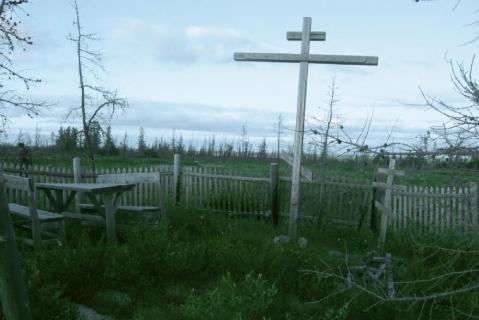The camp at the Obskaya rail station was set up in late 1946 as a sub-division of Sevzheldorlag, becoming the 5th division of Obsklag after 1947. A subdivision of Obsklag (Construction site 501), responsible for building the railroad from Chum to Labytnangi, was also based there. In 1948-1952 brigade 202 of Obsklag, a zone where women who had given birth in captivity and the camp children’s home (for those aged under 7), was deployed near the station.
In 1947-1950 prisoners, children from the home, and free workers were all buried in coffins in a cemetery half a kilometre away. The burials were made in shallow graves; stakes bearing numbers were placed on the graves and in some cases wooden crosses. The cemetery does not have a clearly defined boundary; the graves were made close together.
All the camp sub-divisions closed in 1955. More than 600 graves, 250 of them children’s graves, were uncovered as a result of investigation in the late 1990s. In 2000 after a low fire in the tundra the lids of the coffins caught fire and the burials were exposed. In 2001 an expedition of the Labytnangi branch of the Yamalo-Nenets local history society, led by A.N. Safonov, reburied the remains exposed by the fire in a common grave in the children’s section of the cemetery. In 2002 the area was fenced off and tidied; grave-markers were placed on the new common graves. A memorial cross was erected with the inscription, “Remember them in your Kingdom, O Lord. Here lie children, the victims of repression in the 1950s”.
No Book of Remembrance has been published for the Yamalo-Nenets AO. Information about inhabitants of the autonomous district who were shot or sent to the Gulag is included in the Tyumen Region Book of Remembrance.
Тhe Memorial online database (2025) lists 1,221 individuals who were held in Sevzheldorlag (848 sentenced in 1940) and names 94 who died in captivity but does not specify where they died or were buried.
| Date | Nature of ceremonies | Organiser or responsible person | Participants | Frequency |
|---|---|---|---|---|
|
nk
|
Commemorative Services
|
nk
|
nk
|
From time to time
|
| State of burials | Area | Boundaries |
|---|---|---|
|
The reburial is in good condition; some grave mounds have survived in the cemetery
|
More than 10 hectares
|
not delineated
|
[ Original texts & hyperlinks ]
Archive of the Labytnangi district museum


